
Tucked high above the Sichuan basin where humid clouds brush evergreen slopes, Meng Ding Huang Ya—literally “Yellow Bud from Meng Peak”—has quietly embodied the soul of Chinese yellow tea for twelve centuries. Unlike its green cousin that chases freshness and its sheng puerh sibling that courts age, this yellow gem pursues balance: a fleeting moment when leaf enzymes are coaxed, not coerced, into surrendering grassy edges for mellow orchid sweetness. To the international drinker accustomed to the snap of sencha or the malt of Assam, Meng Ding Huang Ya offers a third path: a liquor the color of topaz that glides across the palate like warm silk, leaving behind a cooling sensation Chinese sommeliers call liang yun—“the shadow of mountain snow.”
Historical scrolls first record the tea in 724 CE when monk Wu Li-zhen planted seven tea bushes on the summit of Meng Ding, believing the mist-shrouded plateau to be the gateway between heaven and earth. Tang dynasty emperors soon declared the harvest imperial tribute; Song dynasty poets compared its aroma to “a jade flute played at dusk”; and Qing merchants traded it ounce-for-ounce with Tibetan warhorses along the Tea-Horse Road. Yet fame also invited imitation. By the 1980s, machine-rolled look-alikes flooded markets, forcing guardians of authenticity to retreat up the mountain and codify a craft so micro-managed that today fewer than 300 households are licensed to produce true Meng Ding Huang Ya.
The cultivar of choice is the local “Meng Ding #9,” a sinensis var. sinensis strain whose young buds down like white velvet in early March. Picking begins when the dawn temperature hovers at 10 °C and the mountain’s relative humidity tops 88 %—conditions that keep cell walls taut and aromatic precursors locked inside. Pluckers take only the “fish-leaf” set: unopened bud plus the first half-expanded leaf, ideally 18–22 mm long. A seasoned picker gathers barely 400 g per hour; 60 000 such sets yield just 500 g of finished tea.
Withering happens not on trays but in the shade of ancient ginkgo trees where filtered sunlight and leaf-mold aromatics season the nascent tea. Three hours later the buds lose 8 % moisture and acquire a faint banana note. The kill-green stage is brief—90 seconds at 160 °C on a hand-rotated wok—just enough to denature polyphenol oxidase while preserving the yellow-green chlorophyll complex. What follows is yellow tea’s signature “sealed yellowing” (men huang). The hot leaves are piled in linen sacks, pressed to release bound steam, then buried inside a bamboo chamber lined with wet goat-hide. Here, at 35 °C and 75 % humidity, the tea stewards in its own juices for 48 hours, undergoing non-enzymatic browning that converts catechins into theaflavins and generates a cascade of lactones responsible for the tea’s hallmark custard aroma. Every six hours the pile is broken up and re-stacked so each bud breathes equally; one lapse and the lot slips into sourness. Finally the leaves are charcoal-baked for three cycles—85 °C, 75 °C, 65 °C—each lasting 20 minutes and separated by 40-minute rests that allow internal moisture to migrate outward. The result is a needle-thin strip, 25 % of its original weight, olive-gold with a downy silver tip.
To brew Meng Ding Huang Ya Western-style, use 3 g per 250 ml glass pot and water cooled to 80 °C. After a 45-second rinse discarded for hygiene, infuse the first steep for 90 seconds. The liquor glows like late-afternoon Chablis, releasing aromas of steamed maize, freesia, and faint toasted almond. On the palate it is weightier than green tea yet brighter than white, with a glycerol texture that suspends flavors long after swallowing. Second steep, 75 °C for 2 minutes, brings out wet limestone minerality; third steep, 80 °C for 3 minutes, reveals a surprising note of lychee peel. Leaves may be pushed to five infusions, but connoisseurs often stop at three to preserve the tea’s elegant arc.
Gongfu aficionados prefer a 120 ml gaiwan and 5 g leaf. Water at 85 °C is poured from a height of 10